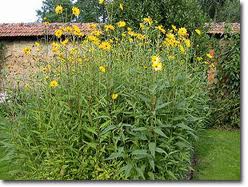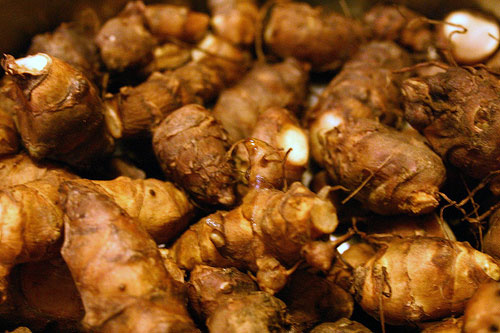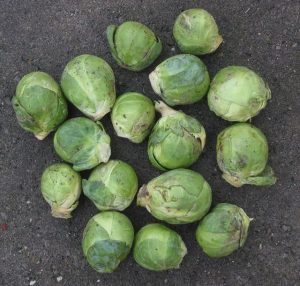What Are Sunchokes?

Sunchokes, also called Jerusalem artichokes, are tubers that come from the plant that looks like the picture on the left. They are often mistakenly destroyed as a weed when it is actually edible and quite tasty. They are ready to harvest right before they bloom. They have a slightly nutty flavor and you can use them in recipes that call for jicama, water chestnuts and almonds. They are very easy to grow and, if you live in North America, you might have actually seen them growing in your backyard or in and around your garden.
Harvesting Jerusalem Artichokes
Growing Sunchokes

Sunchokes do well in fertile loamy soil or the kind of soil found in dried riverbeds. About any soil that potatoes and corn do well in will also work for the sunchoke. These tubers do very well in climates similar to North Carolina, where farmers have reported yields of 5 to 7 tons per acre. They prosper in temperatures of 65 to 80 degrees Fahrenheit and less than 50 inches of rain a year. They should be planted in early spring after the last frost. You can plant whole tubers or pieces of tubers that are no less than 2 ounces in size and have 2 or 3 buds. The tubers should not be allowed to dry out before planting. They can be harvested just after the first frost before they have had a chance to become too sugary. A modified potato harvester works well, or you can mow the tops of the sunchokes and then use a hand rake to locate the tubers. Sunchokes are a perennial plant, so if you miss any tubers you can count on them coming back next year. To avoid bruising and damage to the skin, they should be handled carefully and stored in bins in a high-humidity, low-temperature environment.
Sunchoke Bisque
Sunchoke Soup with Pumpkin Seeds
Ingredients:
- 8 cups water
- 1 1/2 cups white wine vinegar
- 2 pounds sunchokes (Jerusalem artichokes)
- 3 tablespoons butter
- 1 cup each chopped onion and chopped leeks
- 2 garlic cloves chopped
- Salt to taste
- 7 cups vegetable broth
- 1/2 cup heavy whipping cream
- ground white pepper to taste
- shelled pumpkin seeds lightly toasted
- pumpkin seed oil (optional)
- sauteed mushrooms for garnish (optional)
Method:
Mix water and vinegar in a large bowl. Peel sunchokes one at a time and place in bowl to prevent discoloration. Set aside. Melt butter in large pot. Add onions, leeks and garlic; sprinkle salt over and saute over medium heat until soft and translucent. Drain sunchokes and rinse in colandar; shake off excess water. Cut into 1-inch pieces; add to pot and saute 5 minutes. Add vegetable broth; increase heat and bring to boil. Reduce heat to medium low and simmer 1 hour. Puree in batches in a food processor until smooth. If it is too thick, add a little more vegetable broth in 1/4 cup allotments until desired consistency is reached. Stir in whipping cream and season with salt and pepper to taste. Warm on stove until heated through and serve garnished with a drizzle of pumpkin seed oil and mushrooms.
Sunchoke & Roasted Shallot Soup
Fried Sunchoke Chips
Ingredients:
- 2 pounds sunchokes scrubbed
- 1 tablespoon salt
- 1 1/2 teaspoon minced fresh rosemary
- Vegetable oil
Method:
Fill large bowl with cold water or a mix of water and vinegar. Slice sunchokes into 1/16-inch rounds. Drop slices into bowl to prevent discoloration. Rinse thoroughly; shake off excess water and pat dry with paper towels. Pour vegetable oil in skillet, enough to reach depth of 1/2 inch. Using a deep-fry thermometer, preheat oil to 375 degrees. Mix rosemary and salt together in small bowl until well blended. Working in batches, add sunchokes to the oil and fry, stirring occasionally, for 3 to 4 minutes. Transfer to paper towels to drain. Sprinkle rosemary salt evenly over chips.
Sunchoke and Potato Mash
Learn More About the Sunchoke
[simple-rss feed=”http://rest.ebay.com/epn/v1/find/item.rss?keyword=%28sunchoke%2Cjerusalem+artichoke%29&sortOrder=BestMatch&programid=1&campaignid=5337337555&toolid=10039&listingType1=All&lgeo=1&feedType=rss” limit=10 hide_description=”0″]










